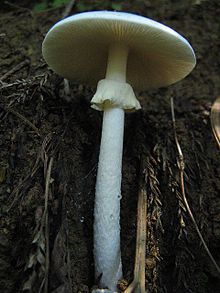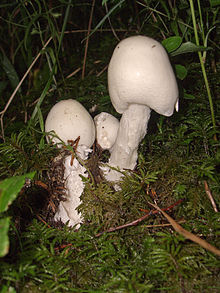Amanita virosa
Amanita virosa was first described in 1838 by Swedish mycologist Elias Magnus Fries as Agaricus virosus, but this name is illegitimate since it had already been used for an earlier and different species.Amanita virosa is found in woodland in late summer and autumn, especially in association with beech and chestnut, but also with pine, spruce, and fir.Amatoxins consist of at least eight compounds with a similar structure, that of eight amino-acid rings; they were isolated in 1941 by Heinrich O. Wieland and Rudolf Hallermayer of the University of Munich.There are four main categories of therapy for poisoning: preliminary medical care, supportive measures, specific treatments, and liver transplantation.[17][18] Supportive measures are directed towards treating the dehydration which results from fluid loss during the gastrointestinal phase of intoxication and correction of metabolic acidosis, hypoglycemia, electrolyte imbalances, and impaired coagulation.High-dose continuous intravenous penicillin G has been reported to be of benefit, though the exact mechanism is unknown,[19] and trials with cephalosporins show promise.[7][20] There is some evidence that intravenous silibinin, an extract from the blessed milk thistle (Silybum marianum), may be beneficial in reducing the effects of death cap poisoning.[27] Other methods of enhancing the elimination of the toxins have been trialed; techniques such as hemodialysis,[28] hemoperfusion,[29] plasmapheresis,[30] and peritoneal dialysis[31] have occasionally yielded success but overall do not appear to improve outcome.[17] That being the case, there has been a reassessment of criteria such as onset of symptoms, prothrombin time (PTT), serum bilirubin, and presence of encephalopathy for determining at what point a transplant becomes necessary for survival.[35][36][37] Evidence suggests that, although survival rates have improved with modern medical treatment, in patients with moderate to severe poisoning up to half of those who did recover suffered permanent liver damage.

Scientific classificationEukaryotaBasidiomycotaAgaricomycetesAgaricalesAmanitaceaeAmanitaBinomial nameSynonymsnom. illegit.Mycological characteristicshymeniumSpore printmycorrhizaldeadlyspeciesfungusBasidiocarpsagaricoidAmanita bisporigeraA. ocreatamycologistElias Magnus FriesillegitimateamyloidMelzer's reagentsodium hydroxideAmanita vernaAmanita phalloidesAgaricuschestnutspruceectomycorrhizalmushroom poisoningsamatoxinsphallotoxinsHeinrich O. WielandUniversity of Munichα-Amanitinβ-AmanitinRNA polymerase IImessenger RNAmicroRNAprotein synthesiskidneysPhalloidinFeodor LynenAmanita rubescensdeath capmedical emergencyliver transplantationactivated carbongastric lavagemetabolic acidosiselectrolytecephalosporinssilibininblessed milk thistlehepatocytesN-acetylcysteineglutathionerandomized clinical trialsenterohepatic circulationhemodialysishemoperfusionplasmapheresisperitoneal dialysiscomplicationsimmunosuppressionprothrombin timebilirubinencephalopathysequelaePseudomonas aeruginosaStaphylococcus aureusin vitrothrombinList of Amanita speciesList of deadly fungiBritish Mycological SocietyBibcodeScientific AmericanA. albocreataA. alienaA. altipesA. apricaA. armeniacaA. augustaA. breckoniiA. chrysoblemaA. diemiiA. eliaeA. farinosaA. frostianaA. gemmataA. gioiosaA. ibotengutakeA. multisquamosaA. muscariaA. nehutaA. orientigemmataA. parcivolvataA. pantherinaA. parvipantherinaA. persicinaA. regalisA. roseotinctaA. rubrovolvataA. velatipesA. virgineoidesA. viscidoluteaA. wellsiiA. xanthocephalaA. arkansanaA. basiiA. calyptratoidesA. calyptrodermaA. caesareaA. caesareoidesA. chepangianaA. hemibaphaA. kitamagotakeA. jacksoniiA. laneiA. princepsA. spreta